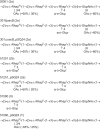Identification of an O-acyltransferase gene (oacB) that mediates 3- and 4-O-acetylation of rhamnose III in Shigella flexneri O antigens
- PMID: 24509314
- PMCID: PMC3993362
- DOI: 10.1128/JB.01393-13
Identification of an O-acyltransferase gene (oacB) that mediates 3- and 4-O-acetylation of rhamnose III in Shigella flexneri O antigens
Abstract
O antigen (O polysaccharide) is an important and highly variable cell component present on the surface of cells which defines the serospecificity of Gram-negative bacteria. Most O antigens of Shigella flexneri, a cause of shigellosis, share a backbone composed of →2)-α-l-Rhap(III)-(1→2)-α-l-Rhap(II)-(1→3)-α-l-Rhap(I)-(1→3)-β-d-GlcpNAc-(1→ repeats, which can be modified by adding various substituents, giving rise to 19 serotypes. The known modifications include glucosylation on various sugar residues, O-acetylation on Rha(I), and phosphorylation with phosphoethanolamine on Rha(II) or/and Rha(III). Recently, two new O-antigen modifications, namely, O-acetylation at position 3 or 4 of Rha(III) and position 6 of GlcNAc, have been identified in several S. flexneri serotypes. In this work, the genetic basis for the 3/4-O-acetylation on Rha(III) was elucidated. Bioinformatic analysis of the genome of S. flexneri serotype 2a strain Sf301, which carries 3/4-O-acetylation on Rha(III), revealed an O-acyltransferase gene designated oacB. Genetic studies combined with O-antigen structure analysis demonstrated that this gene is responsible for the 3/4-O-acetylation in serotypes 1a, 1b, 2a, 5a, and Y but not serotype 6, which has a different O-antigen backbone structure. The oacB gene is carried by a transposon-like structure located in the proA-adrA region on the chromosome, which represents a novel mechanism of mobilization of O-antigen modification factors in S. flexneri. These findings enhance our knowledge of S. flexneri O-antigen modifications and shed light on the origin of new O-antigen variants.
Figures



Similar articles
-
Serotype-converting bacteriophage SfII encodes an acyltransferase protein that mediates 6-O-acetylation of GlcNAc in Shigella flexneri O-antigens, conferring on the host a novel O-antigen epitope.J Bacteriol. 2014 Oct;196(20):3656-66. doi: 10.1128/JB.02009-14. Epub 2014 Aug 11. J Bacteriol. 2014. PMID: 25112477 Free PMC article.
-
Serological identification and prevalence of a novel O-antigen epitope linked to 3- and 4-O-acetylated rhamnose III of lipopolysaccharide in Shigella flexneri.J Clin Microbiol. 2014 Jun;52(6):2033-8. doi: 10.1128/JCM.00197-14. Epub 2014 Mar 26. J Clin Microbiol. 2014. PMID: 24671799 Free PMC article.
-
Genetic and structural identification of an O-acyltransferase gene (oacC) responsible for the 3/4-O-acetylation on rhamnose III in Shigella flexneri serotype 6.BMC Microbiol. 2014 Oct 21;14:266. doi: 10.1186/s12866-014-0266-7. BMC Microbiol. 2014. PMID: 25327486 Free PMC article.
-
O-antigen modifications providing antigenic diversity of Shigella flexneri and underlying genetic mechanisms.Biochemistry (Mosc). 2015 Jul;80(7):901-14. doi: 10.1134/S0006297915070093. Biochemistry (Mosc). 2015. PMID: 26542003 Review.
-
Serotype-converting bacteriophages and O-antigen modification in Shigella flexneri.Trends Microbiol. 2000 Jan;8(1):17-23. doi: 10.1016/s0966-842x(99)01646-7. Trends Microbiol. 2000. PMID: 10637639 Review.
Cited by
-
Serotype-converting bacteriophage SfII encodes an acyltransferase protein that mediates 6-O-acetylation of GlcNAc in Shigella flexneri O-antigens, conferring on the host a novel O-antigen epitope.J Bacteriol. 2014 Oct;196(20):3656-66. doi: 10.1128/JB.02009-14. Epub 2014 Aug 11. J Bacteriol. 2014. PMID: 25112477 Free PMC article.
-
Shigella flexneri serotype 1c derived from serotype 1a by acquisition of gtrIC gene cluster via a bacteriophage.BMC Microbiol. 2016 Jun 27;16(1):127. doi: 10.1186/s12866-016-0746-z. BMC Microbiol. 2016. PMID: 27349637 Free PMC article.
-
Identification of critical residues of O-antigen-modifying O-acetyltransferase B (OacB) of Shigella flexneri.BMC Mol Cell Biol. 2022 Mar 24;23(1):16. doi: 10.1186/s12860-022-00415-8. BMC Mol Cell Biol. 2022. PMID: 35331134 Free PMC article.
-
Bacteriophage Sf6 Tailspike Protein for Detection of Shigella flexneri Pathogens.Viruses. 2018 Aug 15;10(8):431. doi: 10.3390/v10080431. Viruses. 2018. PMID: 30111705 Free PMC article.
-
Bacteriophage Sf6 host range mutant that infects Shigella flexneri serotype 2a2 strains.FEMS Microbiol Lett. 2022 Apr 1;369(1):fnac020. doi: 10.1093/femsle/fnac020. FEMS Microbiol Lett. 2022. PMID: 35218200 Free PMC article.
References
-
- Perepelov AV, Shekht ME, Liu B, Shevelev SD, Ledov VA, Senchenkova SN, L'Vov VL, Shashkov AS, Feng L, Aparin PG, Wang L, Knirel YA. 2012. Shigella flexneri O-antigens revisited: final elucidation of the O-acetylation profiles and a survey of the O-antigen structure diversity. FEMS Immunol. Med. Microbiol. 66:201–210. 10.1111/j.1574-695X.2012.01000.x - DOI - PubMed
-
- Foster RA, Carlin NI, Majcher M, Tabor H, Ng LK, Widmalm G. 2011. Structural elucidation of the O-antigen of the Shigella flexneri provisional serotype 88-893: structural and serological similarities with S. flexneri provisional serotype Y394 (1c). Carbohydr. Res. 346:872–876. 10.1016/j.carres.2011.02.013 - DOI - PubMed
Publication types
MeSH terms
Substances
LinkOut - more resources
Full Text Sources
Other Literature Sources
Molecular Biology Databases

